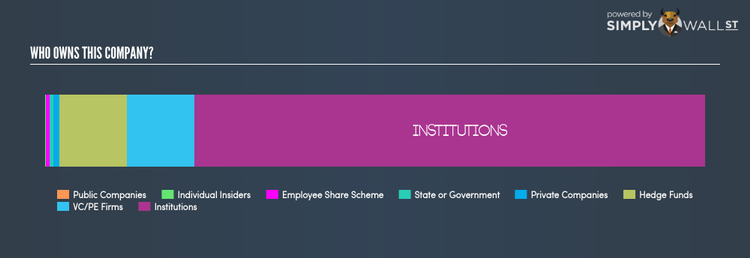Who Are The Largest Shareholders In London Stock Exchange Group plc (LON:LSE)?

In this article, I will take a quick look at London Stock Exchange Group plc’s (LSE:LSE) recent ownership structure – an unconventional investing subject, but an important one. Ownership structure of a company has been found to affect share performance over time. Since the same amount of capital coming from an activist institution and a passive mutual fund has different implications on corporate governance, it is a useful exercise to deconstruct LSE’s shareholder registry. All data provided is as of the most recent financial year end.
See our latest analysis for London Stock Exchange Group
Institutional Ownership
LSE’s 77.96% institutional ownership seems enough to cause large share price movements in the case of significant share sell-off or acquisitions by institutions, particularly when there is a low level of public shares available on the market to trade. These moves, at least in the short-term, are generally observed in an institutional ownership mix comprising of active stock pickers, in particular levered hedge funds, which can cause large price swings. Considering hedge funds hold a stake of 10.24% in the company, LSE shares may experience high short-term volatility as this class of institutions are frequently found to sell significantly during market-wide shocks. I am going to further examine LSE’s ownership structure to check how other major shareholders can affect its investment case.
Insider Ownership
Another important group of shareholders are company insiders. Insider ownership has to do more with how the company is managed and less to do with the direct impact of the magnitude of shares trading on the market. Although individuals in LSE hold only a minor stake, given LSE is a large-cap company, it is relatively meaningful. This is a good sign for shareholders as the company’s executives and directors have their incentives directly linked to the company’s performance. It would also be interesting to check what insiders have been doing with their shareholding recently. Insider buying can be a positive indicator of future performance, but a selling decision can be simply driven by personal financial requirements.
Private Equity Ownership
Private equity firms hold a 10.32% stake in LSE. With a stake of this size, they can be influential in key policy decisions. This is a positive sign for potential investors as these firms play an important role in aligning company policy with shareholder returns.
Private Company Ownership
Potential investors in LSE should also look at another important group of investors: private companies, with a stake of 0.91%, who are primarily invested because of strategic and capital gain interests. However, an ownership of this size may be relatively insignificant, meaning that these shareholders may not have the potential to influence LSE’s business strategy. Thus, investors not need worry too much about the consequences of these holdings.
What this means for you:
With significant institutional ownership, including active hedge, existing investors should seek a margin of safety when investing in LSE. This will allow an investor to reduce the impact of non-fundamental factors, such as volatile block trading impact on their portfolio value. However, ownership structure should not be the only determining factor when you’re building an investment thesis for LSE. Rather, you should be looking at fundamental drivers such as London Stock Exchange Group’s past track record and financial health. I urge you to complete your research by taking a look at the following:
NB: Figures in this article are calculated using data from the last twelve months, which refer to the 12-month period ending on the last date of the month the financial statement is dated. This may not be consistent with full year annual report figures.
To help readers see pass the short term volatility of the financial market, we aim to bring you a long-term focused research analysis purely driven by fundamental data. Note that our analysis does not factor in the latest price sensitive company announcements.
The author is an independent contributor and at the time of publication had no position in the stocks mentioned.


